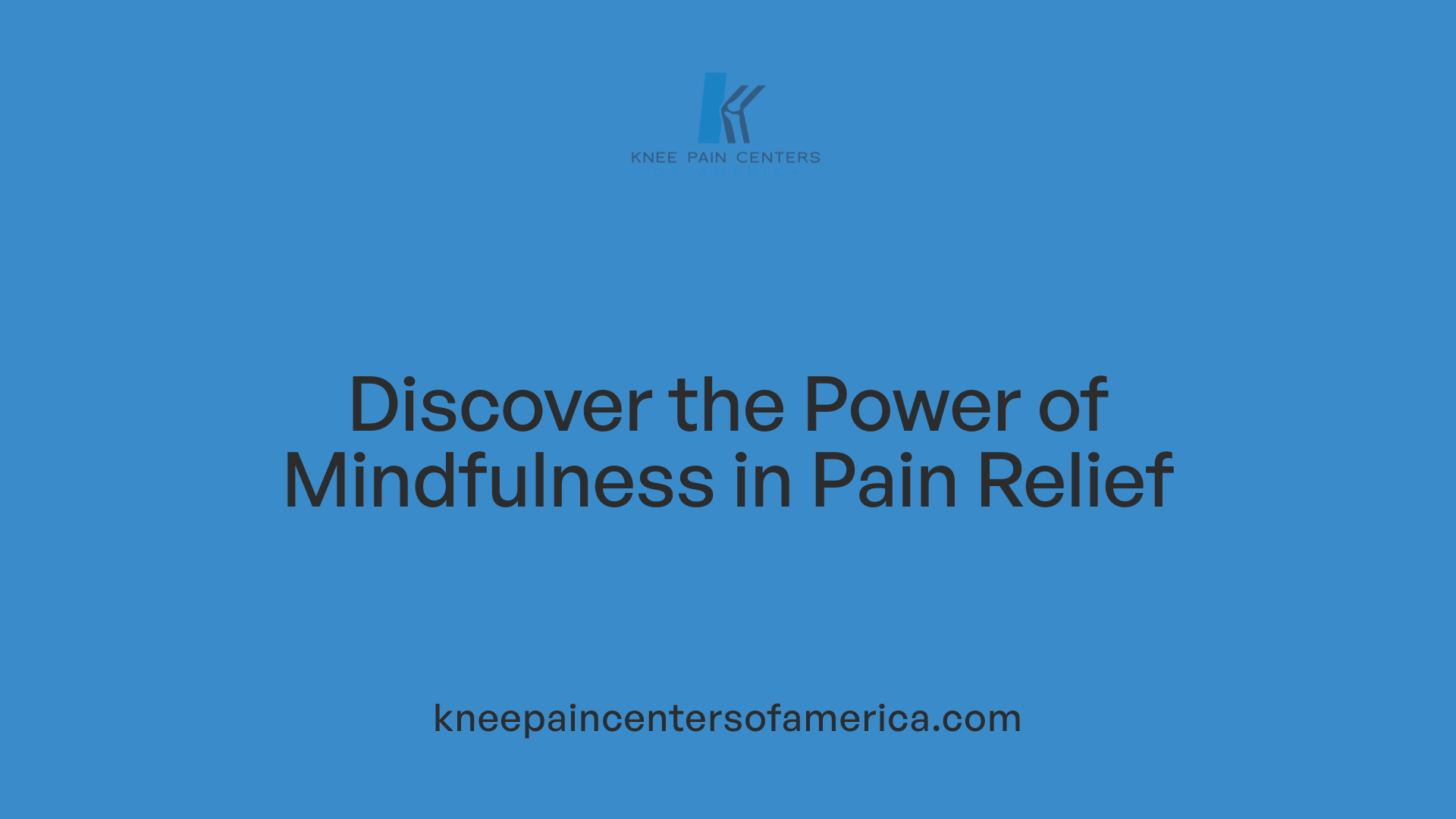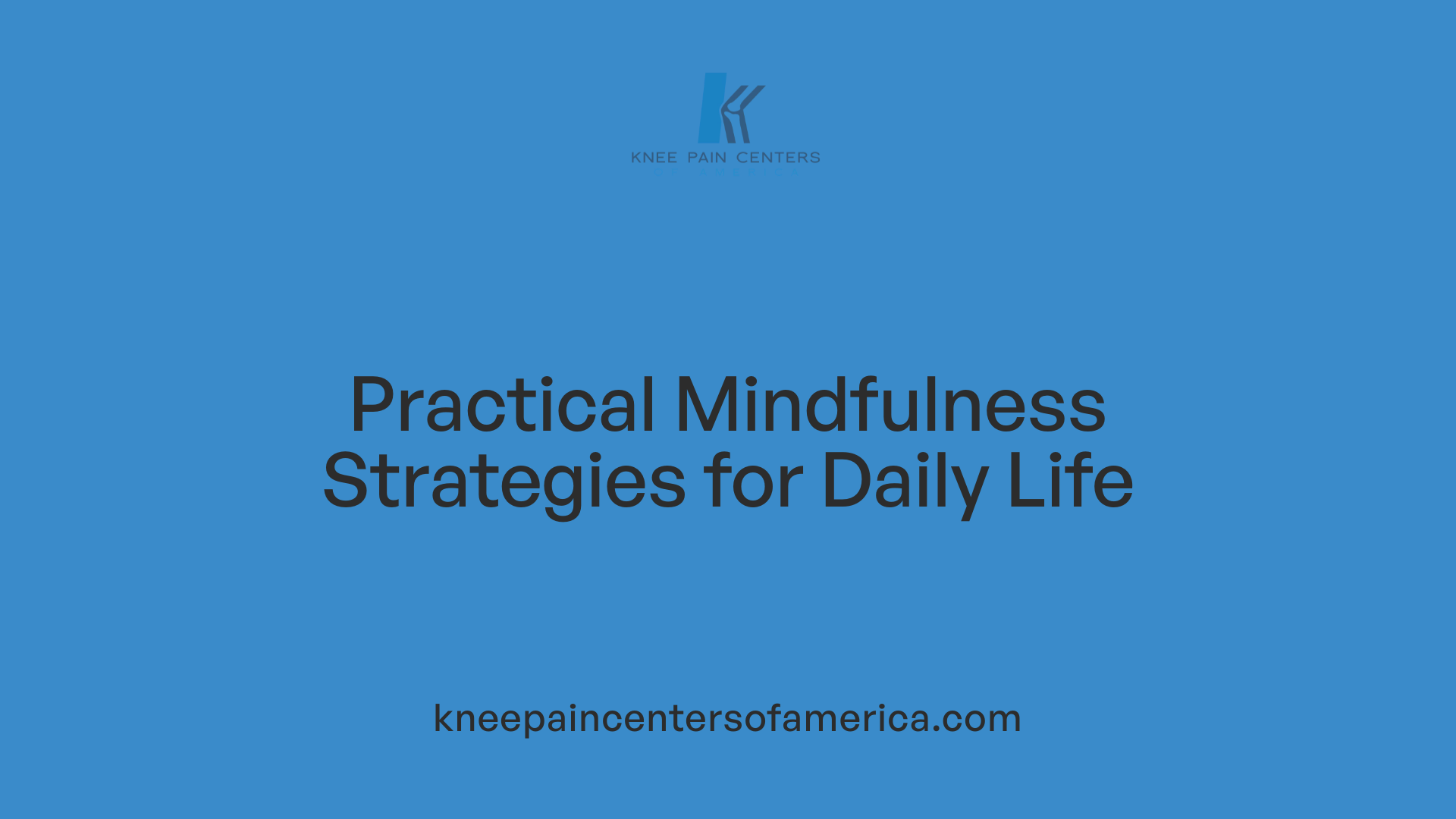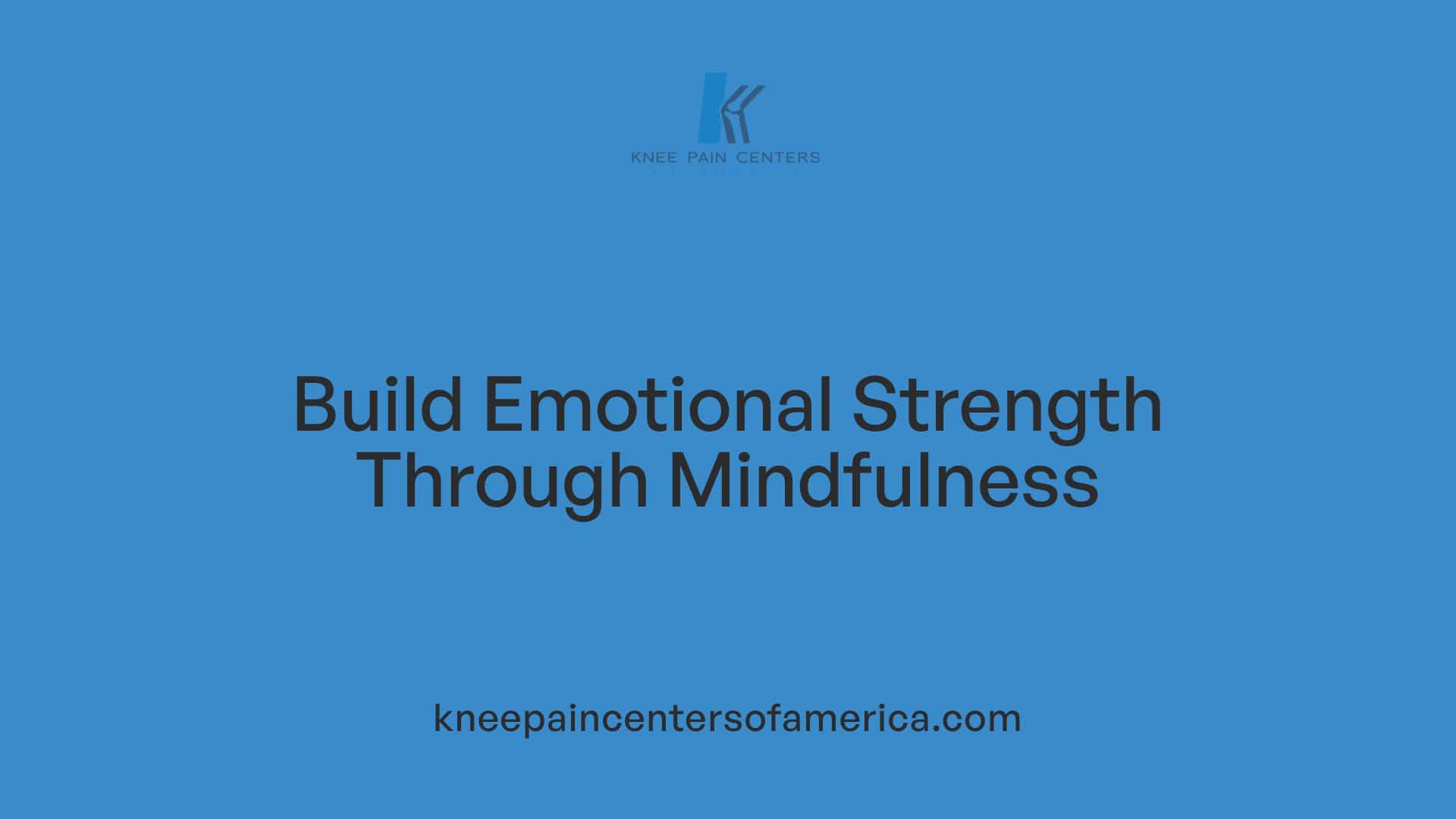Unlocking Natural Pain Management Strategies
Chronic knee pain can be debilitating, affecting mobility and overall quality of life. Traditional treatments often focus on medication, physical therapy, or surgical interventions, but increasingly, mindfulness has emerged as a valuable complementary approach. Rooted in paying purposeful, nonjudgmental attention to present-moment experiences, mindfulness practices can help individuals better manage the emotional and physical aspects of chronic pain. This article explores how mindfulness can be effectively integrated into knee pain management, supported by scientific evidence and practical techniques.
Understanding Mindfulness and Its Role in Pain Management

What is mindfulness and how does it relate to pain management?
Mindfulness, as defined by Jon Kabat-Zinn, is the practice of paying attention on purpose, in the present moment, in a nonjudgmental way. This intentional focus helps individuals become aware of their internal experiences—such as thoughts, emotions, and sensations—without trying to change or suppress them. When applied to pain management, mindfulness encourages a person to observe pain sensations, thoughts about pain, and accompanying emotional responses with openness and acceptance.
Practicing mindfulness can be as simple as paying careful attention during everyday activities like walking, eating, or breathing. It fosters a state of calm alertness that can directly influence how we perceive and respond to pain.
How mindfulness increases awareness of pain, thoughts, and emotions
Through regular mindfulness exercises, individuals learn to recognize pain not merely as a physical sensation but as part of a broader experience that includes emotional and mental reactions. For example, during a body scan meditation, one systematically focuses attention on different body regions, noticing pain or discomfort without trying to avoid or fix it. This helps differentiate between the physical sensation and the feelings or thoughts that might magnify the suffering.
Mindfulness also enhances awareness of the thoughts and emotional states linked to pain. For instance, feelings like frustration or anxiety about chronic knee pain may arise. Recognizing these reactions allows individuals to respond with greater self-compassion and less reactivity.
The neural effects of mindfulness on pain perception
Neuroscientific studies provide compelling evidence of how mindfulness affects brain activity related to pain. Brain imaging reveals that mindfulness activates regions involved in cognitive control and sensory modulation, including the orbitofrontal cortex, anterior cingulate cortex, insula, and thalamus. These areas help in regulating pain signals and reducing their perception.
At the same time, mindfulness reduces activity in brain regions associated with pain evaluation, such as parts of the limbic system, which are involved in emotional responses to pain. This neural shift can diminish the intensity and unpleasantness of pain.
Research has shown that even brief mindfulness sessions can significantly decrease pain experience. Long-term practice enhances these effects, rewiring neural pathways through neuroplasticity, ultimately leading to better pain tolerance and management.
Scientific support for mindfulness in pain relief
Numerous studies support the benefits of mindfulness for pain relief. Neuroimaging research demonstrates that mindfulness meditation alters activity in pain-related brain areas, reducing their activation during pain episodes. Clinical trials indicate that mindfulness interventions can lower pain severity and improve emotional well-being.
Meta-analyses of randomized controlled trials, involving hundreds of patients, find that mindfulness-based interventions lead to meaningful reductions in pain scores, with some individuals experiencing significant relief or even complete remission of pain symptoms. Furthermore, mindfulness has been shown to decrease reliance on medications, offering a non-pharmacological approach to pain management.
Practical application for those with chronic knee pain
For individuals experiencing chronic knee pain, mindfulness offers practical tools to change their pain experience. Techniques like the body scan can be practiced daily, focusing attention on the knees and surrounding areas. This not only promotes relaxation but also helps break the cycle of pain-related anxiety.
Guided mindfulness exercises, including breathing techniques and visualization, can help manage negative thoughts and emotional responses. For example, repeating calming mantras during meditation can reduce stress, which in turn can decrease inflammation and pain levels.
Incorporating mindfulness into a comprehensive pain management plan can improve physical function, mood, and overall quality of life. When combined with other modalities such as gentle exercise, physical therapy, and medical treatment, mindfulness is a valuable approach to handling chronic knee pain.
| Practice Type |
Description |
Benefits |
| Body Scan |
Systematic attention to body parts, noticing sensations |
Promotes relaxation, acceptance, awareness of pain |
| Mindful Breathing |
Focusing on breath, deepening relaxation |
Reduces stress, alleviates pain |
| Guided Imagery |
Visualizing soothing images |
Distracts from pain, emotional relief |
| Mantra Meditation |
Repeating calming phrases |
Decreases pain intensity, improves mood |
By consistently applying these techniques, individuals can better manage their pain and foster a supportive relationship with their body.
Implementing Mindfulness Through Practical Techniques

How can I perform the body scan exercise to support pain management?
The body scan is a core mindfulness technique recommended by Jon Kabat-Zinn for managing pain. To begin, find a quiet place where you can lie down comfortably. Close your eyes and take slow, deep breaths, focusing your attention on your inhalations and exhalations. Start at your toes, paying close attention to any sensations, whether warmth, tingling, or tension. Gradually move your focus upward through your feet, legs, torso, arms, and finally your head. During this process, acknowledge any pain or discomfort in each area without trying to change or suppress it. Instead, breathe into those sensations, allowing them to be present without judgment. This iterative focus helps increase awareness and promotes relaxation.
Why is acknowledging pain and accompanying thoughts important during mindfulness practice?
Accepting pain and related thoughts or emotions while practicing mindfulness fosters a compassionate attitude toward oneself. When you notice pain—whether physical, emotional, or mental—acknowledge it gently, without pushing away or resisting. This acknowledgment can reduce emotional suffering tied to pain and break the cycle of reactivity. Breathing through discomfort helps maintain calmness and resilience. The goal isn’t to eliminate pain immediately but to observe it objectively, which can lessen its intensity over time.
How can I incorporate mindfulness into daily routines?
Mindfulness doesn't have to be confined to formal meditation sessions. Integrate it into everyday activities such as walking, eating, or routine chores like washing dishes or showering. When walking, pay attention to the sensation of your feet touching the ground, the sounds around you, and your body movements. During meals, focus on the taste, texture, and aroma of your food. During chores, notice the sensory experiences involved in washing or tidying. Additionally, mindful breathing or grounding techniques during breaks can help maintain calmness, reducing stress that might exacerbate pain.
What resources and group activities can deepen mindfulness practice?
There are many resources available to support your mindfulness journey. Smartphone apps like Headspace or Calm offer guided meditations tailored for pain management. The Mayo Clinic provides free audio resources and online instructions for beginner and advanced practices. Books by Jon Kabat-Zinn and online videos on platforms like YouTube also serve as excellent guides.
Joining local mindfulness or meditation groups can provide communal support and accountability, which enhances consistency. Participating in structured programs like Mindfulness-Based Stress Reduction (MBSR) can offer comprehensive training, often tailored for pain and chronic conditions. These resources and communities help establish a regular practice that deepens understanding and effectiveness.
| Technique Type |
Implementation Example |
Additional Details |
| Body Scan Meditation |
Lying down, focusing on each body part systematically |
Promotes relaxed awareness of sensations |
| Mindful Walking |
Paying attention to each step and surroundings |
Can be done indoors or outdoors |
| Routine Activity Mindfulness |
Focusing on sensory experiences during daily chores |
Turning mundane tasks into meditation |
| Guided Meditations and Apps |
Using apps like Headspace, Calm, or Mayo Clinic guides |
Convenient, accessible, and varied |
| Group and Course Participation |
Attending local mindfulness groups or MBSR courses |
Provides community support and structure |
Regularly practicing these techniques helps build resilience, reduces emotional distress, and enhances your ability to manage pain over time. Remember, consistency and patience are essential in cultivating mindfulness as a supportive component of your pain management toolkit.
Supporting Emotional Resilience and Mindful Acceptance

How can mindfulness help individuals cope emotionally with chronic knee pain?
Mindfulness offers valuable emotional support for people living with chronic knee pain by encouraging a focus on acceptance rather than resistance. When practicing mindfulness, individuals learn to acknowledge their pain without judgment, which reduces emotional reactivity and stress. This acceptance helps diminish feelings of frustration or despair that often accompany ongoing pain.
By continually paying attention to pain sensations and associated thoughts or emotions with kindness and openness, individuals can observe these experiences objectively. This process fosters emotional resilience, helping them manage feelings of depression, anxiety, or sadness related to their condition.
Recognizing personal strengths and milestones—such as improvements in mobility or successful daily routines—can significantly reinforce resilience. Celebrating these achievements fosters a sense of progress and hope, which are essential in mental health management.
Creating a supportive internal dialogue is crucial. Using positive affirmations, such as “I am strong,” “I am making progress,” or “My body is resilient,” can build a more compassionate relationship with oneself. This kindness toward oneself encourages a mindset that accepts pain as part of the human experience rather than a negative reflection of personal failure.
Research supports that mindfulness can reduce symptoms of depression and anxiety commonly experienced in chronic pain sufferers. It encourages a shift from focusing on pain and limitations toward a broader awareness of strengths, sensations, and feelings. This shift fosters a more positive outlook and helps individuals develop adaptive coping strategies.
Overall, mindfulness techniques enhance emotional well-being by promoting acceptance, reducing distress, and cultivating a compassionate internal environment. When integrated into daily routines, these practices can transform emotional responses to pain, creating a foundation for resilience and improved mental health.
Supporting Information
| Aspect |
How Mindfulness Contributes |
Additional Notes |
| Recognizing Strengths |
Celebrating progress reinforces resilience |
Acknowledging milestones boosts motivation |
| Internal Dialogue |
Positive affirmations foster self-compassion |
Cultivating kindness toward oneself |
| Emotional Well-being |
Reduces depression and anxiety |
Encourages acceptance and peace |
| Daily Practice |
Incorporating mindfulness builds resilience |
Consistency enhances benefits |
Mindfulness, therefore, is not only a tool for pain management but also an approach that nurtures mental health and emotional strength in those dealing with chronic knee pain.
Harnessing Mindfulness for Lasting Pain Relief
Incorporating mindfulness into chronic knee pain management offers a scientifically supported, accessible, and cost-effective strategy to improve physical comfort and emotional well-being. Through consistent practice of techniques like the body scan, mindful breathing, and guided imagery, individuals can rewire their brains, reduce pain perception, and foster acceptance. As research continues to validate these approaches, mindfulness remains a promising complement to conventional treatments, empowering individuals to manage their pain with resilience and confidence. Whether through formal meditation sessions or integrating mindfulness into daily routines, embracing this practice can lead to a more peaceful, empowered approach to chronic knee pain.
References